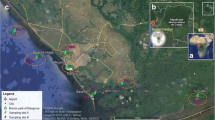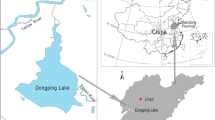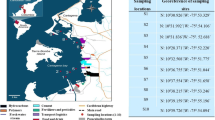Abstract
During the last decades, the Berre lagoon, located in southeastern France, has been deeply affected by strong contaminant inputs. Surveys of surface sediment contamination have been sparsely performed since 1964 with data often disconnected with regard to time and space. To contribute to filling this gap, this study examined the pollution status of the lagoon during a 2012 sampling. Concentrations of heavy metals (HMs) (cadmium [Cd], chromium [Cr], copper [Cu], lead [Pb], and zinc [Zn]), organochlorine pesticides (OCPs), and polycyclic aromatic hydrocarbons were examined. The available seawater metal fraction was also investigated. Water from the Vaine basin (VB; stations 1 through 6) exhibited the lowest oxygen concentration (mean O2 % saturation 38.9 %). HM loads were in the order of Zn > Cr > Pb > Cu > Cd with overall concentration ranges of 0.20–1.40 mg kg−1 for Cd, 17.1–119 mg kg−1 for Cr, 7.0–60.7 g−1 for Cu, 12.0–104 mg kg−1 for Pb, and 56.5–215 mg kg−1 for Zn. Although HMs accumulated at levels largely exceeding their relative natural background level of 11-fold for Pb and 80-fold for Zn, their mean concentrations decreased largely to below the acceptable legal limits. HM loads were 20 to threefold the relative corresponding value of the threshold effect level benchmark of potential biological risk. Metals were only scantly released by sediments with mean percentage release of 0.99 % for Cd and 40.2 % for Cr with a peak for this latter element of 99 % in the VB sector. In the case of OCPs, sediments appeared to be significantly polluted, especially in the VB area, with a mean lindane concentration of 0.05 mg kg−1, which is ≤fivefold the legal threshold. Among PAHs, benzo[a]pyrene exceeded the permitted limit of 0.1 mg kg−1 mainly in the VB sector.

Similar content being viewed by others
References
Accornero A, Gnerre R, Manfra L (2008) Sediment concentrations of trace metals in the Berre lagoon (France): an assessment of contamination. Arch Environ Contam Toxicol 54:372–385
Arnoux A (1997) Commentaires sur l’évolution récente des sédiments de l’étang de Berre (1994–1996). Université de la Méditerranée: Laboratoire d’Hydrologie et de Molysmologie Aquatique, Marseille
Arnoux A, Roux MR (1987) Etude sédimentologique, minéralogique et géochimique de la carotte n 3 e Berre. Université Aix-Marseille II: Laboratoire d’Hydrologie et de Molysmologie Aquatique, Marseille
Bernard G, Boudouresque CF, Picon P (2007) Long-term changes in Zostera meadows in the Berre Lagoon (Provence, Mediterranean sea). Estuar Coast Shelf Sci 73:617–629
Bouchard P (1981) Etude de l’état de pollution des sédiments de l’étang de Berre. 1ère partie: La pollution organique. Université de Marseille, Marseille
Canadian Council of Ministers of the Environment (2002) Canadian sediment quality guidelines for the protection of aquatic lives. Summary tables. Update. In: Canadian Council of Ministers of the Environment, Winnipeg, Canada
Cicchella D, De Vivo B, Lima A, Albanese S, McGill RAR, Parrish RR (2008) Heavy metal pollution and Pb isotopes in urban soils of Napoli, Italy. Geochem Explor Environ Anal 8:103–112
Dagregorio JM (1985) Evolution chimique des fonds de l’étang de Berre entre 1976 et 1981. Faculté de Pharmacie, Marseille
Forstner U (1987) Sediment-associated contaminants: an overview of scientific bases for developing remedial options. Hydrobiologia 149:221–246
Georgeaud V, Rochette P, Ambrosi JP, Vandamme D, Williamson D (1997) Relationship between heavy metals and magnetic properties in a large polluted catchment: the Etang de Berre (South of France). Phys Chem Earth 22:211–214
Giorgetti C (1981) Etude de l’état de pollution des sédiments de l’étang de Berre. 2ème partie: La pollution inorganique. Université de Marseille, Marseille
GIPREB (2002) Etang de Berre: Etat de sante du milieu, bilan des connaissances. Marseille
Gleize N (2006) Pollution métallique de l’étang de Berre. Ecole Doctorale des Sciences de l’Environnement. Université Aix-Marseille III, Marseille
Gouze E, Raimbault P, Garcia N, Bernard G, Picon P (2008) Nutrient and suspended matter discharge by tributaries into the Berre Lagoon (France): the contribution of flood events to the matter budget. Geoscience 340:233–244
Grant A, Briggs AD (2002) Toxicity of sediments from around a North Sea oil platform: are metals or hydrocarbons responsible for ecological impacts? Mar Environ Res 53:95–116
Greenpeace (2002) Toxiques en Bouches du Rhone, Groupe local de Marseille, Campagne toxiques. Available at: http://www.greenpeace.fr/gl/marseille
Grossl P, Eick M, Sparks DL, Goldberg S, Ainsworth CC (1997) Arsenate and chromate retention mechanisms on Goethite. 2. Kinetic evaluation using a pressure-jump relaxation technique. Environ Sci Technol 31:321–326
Kim KT, Travers M (1997) Les nutriments dans l’étang de Berre et des milieux aquatiques contigus (eaux douces, saumâtres et marines, Méditerranée NW)—2: Les nitrates. Mar Nat 5:35–48
Milenkovic N, Damjanovic M, Ristic M (2005) Study of heavy metal pollution in sediments from the Iron Gate (Danube River), Serbia and Montenegro. Pol J Environ Stud 14:781–787
Naidu S, Blanchard A, Kelley JJ, Goering JJ, Hameedi MJ, Baskaran M (1997) Heavy metals in Chukchi Sea sediments as compared to selected circum-arctic shelves. Mar Pollut Bull 35:260–269
Oana PM (2006) Chromium impact on marine ecosystem. Bull USAMV-CN 63:379–384
Official Bulletin of the Italian Republic (2006) Law no. 152. 88 14, April. Environmental rules. Ordinary supplement, 96
Picon P (2002) Étang de Berre: Bilan des connaissances—État de santé du milieu. GIPREB Report
Rebouillon P, Diana C, Monod JL (1998) Rapport “Sédiment 1998”—Etang de Berre. Université de la Méditerranée: Laboratoire d’Hydrologie et de Molysmologie, Marseille
Rebouillon P, Monod JL, Diana C, Sarrazin L, Wafo E, Schembri T et al (2000) Rapport “Sédiment 2000”—Etang de Berre. In: Laboratoire d’Hydrologie et de Molysmologie Aquatique, Universite de la Méditerranée, Marseille
Rigaud S, Radakovitch O, Nerini D, Picon P, Garnier JM (2011) Reconstructing historical trends of Berre lagoon contamination from surface sediment datasets: influences of industrial regulations and anthropogenic silt inputs. J Environ Manag 92:2201–2210
Roux RM (1983) L’étang de Berre—Sédiments et dynamique sédimentaire. Centre National Pour l’Exploitation des Océans, France
Savvides C, Papadopoulos A, Haralambous KJ, Luizidou M (1995) Sea sediments contaminated with heavy metals: metal speciation and removal. Water Sci Technol 32:65–73
Schantz MM, Parris RM, Kurz J, Ballschmiter K, Wise SA (1993) J Anal Chem 346:766–778
Soares HMVM, Boaventura RAR, Machado AASC, Esteves de Silva JCG (1999) Sediment as monitors of trace metal contamination in the Ave river basin (Portugal): multivariate analysis of data. Environ Pollut 115:311–323
United Nations Environment Programme (UNEP) (1984) Regionally based assessment of persistent toxic substances Mediterranean Regional. UNEP/FAO/IAEA. Reference methods for marine pollution 12 (Rev. 1)
Wong PTS, Silverberg BA, Chau YK, Hodson PV (1978) Lead and the aquatic biota. In: Nriagu JO (ed) The biogeochemistry of lead in the environment. Part B. Biological effects. Elsevier/North Holland Biomedical Press, Amsterdam, pp 279–342
VROM (2000) Intervention and target values-soil quality standards. Available at: http://www.minvrom.nl/minvrom/docs/bodem/annexS&I2000.pdf. Accessed 15 Jan 2013
Zalups RK, Koropatnick J (2000) Molecular biology and toxicology of metals. Taylor & Francis, New York
Acknowledgments
We thank all of the personnel from the Laboratory Fisiopharma for helping with part of the analytical work as well as its director, Dr. Petti, for valuable support.
Author information
Authors and Affiliations
Corresponding author
Rights and permissions
About this article
Cite this article
Arienzo, M., Masuccio, A.A. & Ferrara, L. Evaluation of Sediment Contamination by Heavy Metals, Organochlorinated Pesticides, and Polycyclic Aromatic Hydrocarbons in the Berre Coastal Lagoon (Southeast France). Arch Environ Contam Toxicol 65, 396–406 (2013). https://doi.org/10.1007/s00244-013-9915-3
Received:
Accepted:
Published:
Issue Date:
DOI: https://doi.org/10.1007/s00244-013-9915-3




